Cormorants and shags are medium-to-large birds, with body weight in the range of 0.35–5 kilograms (0.77–11.02 lb) and wing span of 45–100 centimetres (18–39 in). The majority of species have dark feathers. The bill is long, thin and hooked. Their feet have webbing between all four toes. All species are fish-eaters, catching the prey by diving from the surface. They are excellent divers, and under water they propel themselves with their feet with help from their wings; some cormorant species have been found to dive as deep as 45 metres (150 ft). They have relatively short wings due to their need for economical movement underwater, and consequently have the highest flight costs of any flying bird.[2]
Cormorants nest in colonies around the shore, on trees, islets or cliffs. They are coastal rather than oceanic birds, and some have colonised inland waters – indeed, the original ancestor of cormorants seems to have been a fresh-water bird.[citation needed] They range around the world, except for the central Pacific islands.
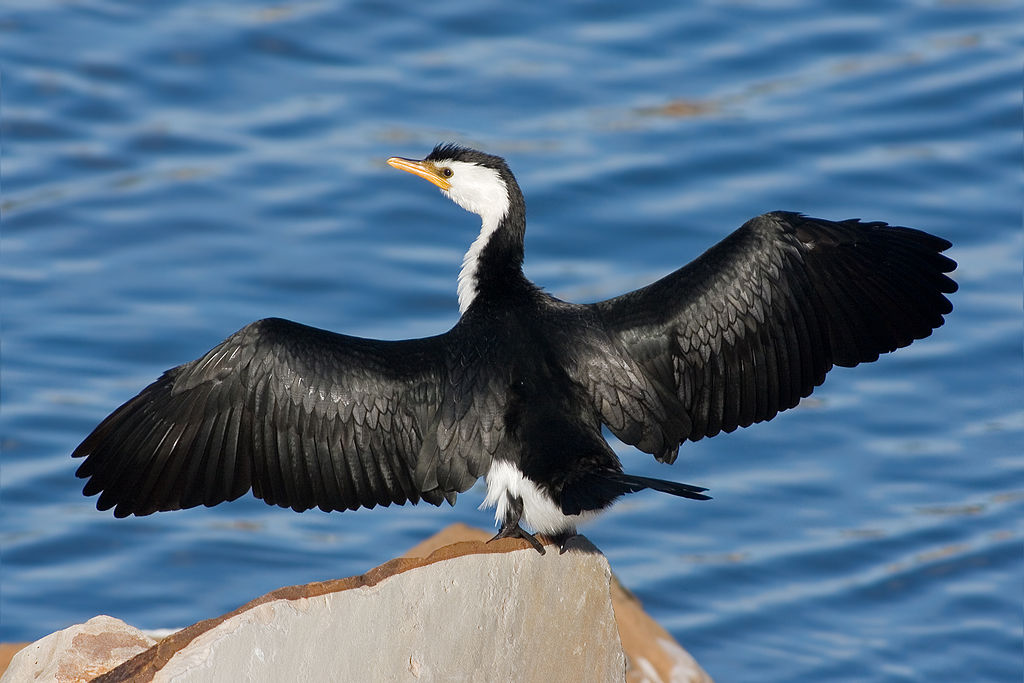
Names
No consistent distinction exists between cormorants and shags. The names 'cormorant' and 'shag' were originally the common names of the two species of the family found in Great Britain, Phalacrocorax carbo (now referred to by ornithologists as the great cormorant) and P. aristotelis (the European shag). "Shag" refers to the bird's crest, which the British forms of the great cormorant lack. As other species were encountered by English-speaking sailors and explorers elsewhere in the world, some were called cormorants and some shags, depending on whether they had crests or not. Sometimes the same species is called a cormorant in one part of the world and a shag in another, e.g., the great cormorant is called the black shag in New Zealand (the birds found in Australasia have a crest that is absent in European members of the species). Van Tets (1976) proposed to divide the family into two genera and attach the name "cormorant" to one and "shag" to the other, but this flies in the face of common usage and has not been widely adopted.The scientific genus name is Latinised Ancient Greek, from φαλακρός (phalakros, "bald") and κόραξ (korax, "raven").[3] This is often thought to refer to the creamy white patch on the cheeks of adult great cormorants, or the ornamental white head plumes prominent in Mediterranean birds of this species, but is certainly not a unifying characteristic of cormorants. "Cormorant" is a contraction derived either directly from Latin corvus marinus, "sea raven" or through Brythonic Celtic. Cormoran is the Cornish name of the sea giant in the tale of Jack the Giant Killer. Indeed, "sea raven" or analogous terms were the usual terms for cormorants in Germanic languages until after the Middle Ages. The French explorer André Thévet commented in 1558, "... the beak [is] similar to that of a cormorant or other corvid," which demonstrates that the erroneous belief that the birds were related to ravens lasted at least to the 16th century.
Description
Great cormorant with hooked bill
Cormorant in Mainaguri
Habitat
Imperial shags in Beagle Channel
Behaviour
All are fish-eaters, dining on small eels, fish, and even water snakes. They dive from the surface, though many species make a characteristic half-jump as they dive, presumably to give themselves a more streamlined entry into the water. Under water they propel themselves with their feet, though some also propel themselves with their wings (see the picture,[4] commentary,[5] and existing reference video[6]). Some cormorant species have been found, using depth gauges, to dive to depths of as much as 45 metres (150 ft).
Wing-drying behaviour
Cormorants are colonial nesters, using trees, rocky islets, or cliffs. The eggs are a chalky-blue colour. There is usually one brood a year. The young are fed through regurgitation. They typically have deep, ungainly bills, showing a greater resemblance to those of the pelicans, to which they are related, than is obvious in the adults.
Taxonomy
The cormorants are a group traditionally placed within the Pelecaniformes or, in the Sibley–Ahlquist taxonomy, the expanded Ciconiiformes. This latter group is certainly not a natural one, and even after the tropicbirds have been recognised as quite distinct, the remaining Pelecaniformes seem not to be entirely monophyletic. Their relationships and delimitation – apart from being part of a "higher waterfowl" clade which is similar but not identical to Sibley and Ahlquist's "pan-Ciconiiformes" – remain mostly unresolved. Notwithstanding, all evidence agrees that the cormorants and shags are closer to the darters and Sulidae (gannets and boobies), and perhaps the pelicans or even penguins, than to all other living birds.[16]In recent years, three preferred treatments of the cormorant family have emerged: either to leave all living cormorants in a single genus, Phalacrocorax, or to split off a few species such as the imperial shag complex (in Leucocarbo) and perhaps the flightless cormorant. Alternatively, the genus may be disassembled altogether and in the most extreme case be reduced to the great, white-breasted and Japanese cormorants.[17]
Pending a thorough review of the Recent and prehistoric cormorants, the single-genus approach[18] is followed here for three reasons: first, it is preferable to tentatively assigning genera without a robust hypothesis. Second, it makes it easier to deal with the fossil forms, the systematic treatment of which has been no less controversial than that of living cormorants and shags. Third, this scheme is also used by the IUCN,[19] making it easier to incorporate data on status and conservation. In accordance with the treatment there, the imperial shag complex is here left unsplit as well, but the king shag complex has been.
Occipital crest or os nuchale in Phalacrocorax carbo
Several evolutionary groups are still recognizable. However, combining the available evidence suggests that there has also been a great deal of convergent evolution; for example the cliff shags are a convergent paraphyletic group. The proposed division into Phalacrocorax sensu stricto (or subfamily "Phalacrocoracinae") cormorants and Leucocarbo sensu lato (or "Leucocarboninae") shags[24] does indeed have some degree of merit.[25] The resolution provided by the mtDNA 12S rRNA and ATPase subunits six and eight sequence data[25] is not sufficient to properly resolve several groups to satisfaction; in addition, many species remain unsampled, the fossil record has not been integrated in the data, and the effects of hybridisation – known in some Pacific species especially – on the DNA sequence data are unstudied.
List of genera
Cormorant (species unknown) begins its dive
Immature Phalacrocorax atriceps albiventer
Guanay cormorant (Phalacrocorax bougainvillii) at Weltvogelpark Walsrode
- Microcarbo (5 species)
- Phalacrocorax (22 species, including one extinct in 19th century)
- Leucocarbo (15 species)
Evolution and fossil record
Cormorants seem to be a very ancient group, with similar ancestors reaching back to the time of the dinosaurs. In fact, the earliest known modern bird, Gansus yumenensis, had essentially the same structure. The details of the evolution of the cormorant are mostly unknown. Even the technique of using the distribution and relationships of a species to figure out where it came from, biogeography, usually very informative, does not give very specific data for this probably rather ancient and widespread group. However, the closest living relatives of the cormorants and shags are the other families of the suborder Sulae—darters and gannets and boobies—which have a primarily Gondwanan distribution. Hence, at least the modern diversity of Sulae probably originated in the southern hemisphere.While the Leucocarbonines are almost certainly of southern Pacific origin—possibly even the Antarctic which, at the time when cormorants evolved, was not yet ice-covered—all that can be said about the Phalacrocoracines is that they are most diverse in the regions bordering the Indian Ocean, but generally occur over a large area.
Similarly, the origin of the family is shrouded in uncertainties. Some Late Cretaceous fossils have been proposed to belong with the Phalacrocoracidae:
A scapula from the Campanian-Maastrichtian boundary, about 70 mya (million years ago), was found in the Nemegt Formation in Mongolia; it is now in the PIN collection.[27] It is from a bird roughly the size of a spectacled cormorant, and quite similar to the corresponding bone in Phalacrocorax. A Maastrichtian (Late Cretaceous, c. 66 mya) right femur, AMNH FR 25272 from the Lance Formation near Lance Creek, Wyoming, is sometimes suggested to be the second-oldest record of the Phalacrocoracidae; this was from a rather smaller bird, about the size of a long-tailed cormorant.[28]
As the Early Oligocene Sula" ronzoni cannot be assigned to any of the suloid families—cormorants and shags, darters, and gannets and boobies—with certainty, the best interpretation is that the Phalacrocoracidae diverged from their closest ancestors in the Early Oligocene, perhaps some 30 million years ago, and that the Cretaceous fossils represent ancestral suloids, "pelecaniforms" or "higher waterbirds"; at least the last lineage is generally believed to have been already distinct and undergoing evolutionary radiation at the end of the Cretaceous. What can be said with near certainty is that AMNH FR 25272 is from a diving bird that used its feet for underwater locomotion; as this is liable to result in some degree of convergent evolution and the bone is missing indisputable neornithine features, it is not entirely certain that the bone is correctly referred to this group.[29]
During the late Paleogene, when the family presumably originated, much of Eurasia was covered by shallow seas, as the Indian Plate finally attached to the mainland. Lacking a detailed study, it may well be that the first "modern" cormorants were small species from eastern, south-eastern or southern Asia, possibly living in freshwater habitat, that dispersed due to tectonic events. Such a scenario would account for the present-day distribution of cormorants and shags and is not contradicted by the fossil record; as remarked above, a thorough review of the problem is not yet available.
Double-crested cormorant
- Limicorallus (Indricotherium middle Oligocene of Chelkar-Teniz, Kazakhstan)
- Nectornis (Late Oligocene/Early Miocene of Central Europe – Middle Miocene of Bes-Konak, Turkey) – includes Oligocorax miocaenus
Some other Paleogene remains are sometimes assigned to the Phalacrocoracidae, but these birds seem quite intermediate between cormorants and darters (and lack clear autapomorphies of either). Thus, they may be quite basal members of the Palacrocoracoidea. The taxa in question are:
- Piscator (Late Eocene of England)
- "Pelecaniformes" gen. et sp. indet. (Jebel Qatrani Early Oligocene of Fayum, Egypt) – similar to Piscator?
- Borvocarbo (Late Oligocene of C Europe)
The remaining species are, in accordance with the scheme used in this article, all placed in the modern genus Phalacrocorax:
- Phalacrocorax marinavis (Oligocene – Early Miocene of Oregon, US) – formerly Oligocorax
- Phalacrocorax littoralis (Late Oligocene/Early Miocene of St-Gérand-le-Puy, France) – formerly Oligocorax, might belong into Nectornis
- Phalacrocorax intermedius (Early – Middle Miocene of C Europe) – includes P. praecarbo, Ardea/P. brunhuberi and Botaurites avitus
- Phalacrocorax macropus (Early Miocene – Pliocene of north-west US)
- Phalacrocorax ibericus (Late Miocene of Valles de Fuentiduena, Spain)
- Phalacrocorax lautus (Late Miocene of Golboçica, Moldavia)
- Phalacrocorax serdicensis (Late Miocene of Hrabarsko, Bulgaria)
- Phalacrocorax femoralis (Modelo Late Miocene/Early Pliocene of WC North America) – formerly Miocorax
- Phalacrocorax sp. (Late Miocene/Early Pliocene of Lee Creek Mine, US)
- Phalacrocorax longipes (Late Miocene – Early Pliocene of the Ukraine) – formerly Pliocarbo
- Phalacrocorax goletensis (Early Pliocene – Early Pleistocene of Mexico)
- Phalacrocorax wetmorei (Bone Valley Early Pliocene of Florida)
- Phalacrocorax sp. (Bone Valley Early Pliocene of Polk County, Florida, US)[30]
- Phalacrocorax leptopus (Juntura Early/Middle Pliocene of Juntura, Malheur County, Oregon, US)
- Phalacrocorax idahensis (Middle Pliocene – Pleistocene of Idaho, US)
- Phalacrocorax destefanii[verification needed] (Late Pliocene of Italy) – formerly Paracorax
- Phalacrocorax filyawi (Pinecrest Late Pliocene of Florida, US) – may be P. idahensis
- Phalacrocorax kumeyaay (San Diego Late Pliocene of California, US)
- Phalacrocorax macer (Late Pliocene of Idaho, US)
- Phalacrocorax mongoliensis (Late Pliocene of W Mongolia)
- Phalacrocorax rogersi (Late Pliocene – Early Pleistocene of California, US)
- Phalacrocorax kennelli (San Diego Pliocene of California, US)
- Phalacrocorax sp. "Wildhalm"[verification needed] (Pliocene) – may be same as P. longipes[31]
- Phalacrocorax chapalensis (Late Pliocene/Early Pleistocene of Jalisco, Mexico
- Phalacrocorax gregorii (Late Pleistocene of Australia) – possibly not a valid species
- Phalacrocorax vetustus (Late Pleistocene of Australia) – formerly Australocorax, possibly not a valid species
- Phalacrocorax reliquus
- Phalacrocorax sp. (Sarasota County, Florida, US) – may be P. filawyi/idahensis
In human culture
Cormorant fishing
A Chinese fisherman with his two cormorants
In a common technique, a snare is tied near the base of the bird's throat, which allows the bird only to swallow small fish. When the bird captures and tries to swallow a large fish, the fish is caught in the bird's throat. When the bird returns to the fisherman's raft, the fisherman helps the bird to remove the fish from its throat. The method is not as common today, since more efficient methods of catching fish have been developed, but is still practiced as a cultural tradition.[34][33]
In folklore, literature, and art
Cormorants catching Fish. Hanging silk scroll by Yūhi, Middle Edo period, Japan, 1755
Cormorants feature in heraldry and medieval ornamentation, usually in their "wing-drying" pose, which was seen as representing the Christian cross, and symbolizing nobility and sacrifice. For John Milton in Paradise Lost, the cormorant symbolizes greed: perched atop the Tree of Life, Satan took the form of a cormorant as he spied on Adam and Eve during his first intrusion into Eden.[36]
In some Scandinavian areas, they are considered good omen; in particular, in Norwegian tradition spirits of those lost at sea come to visit their loved ones disguised as cormorants.[36] For example, the Norwegian municipalities of Røst, Loppa and Skjervøy have cormorants in their coat of arms. The symbolic liver bird of Liverpool is commonly thought to be a cross between an eagle and a cormorant.
In 1853, a woman wearing a dress made of cormorant feathers was found on San Nicolas Island, off the southern coast of California. She had sewn the feather dress together using whale sinews. She is known as the Lone Woman of San Nicolas and was later baptised "Juana Maria" (her original name is lost). The woman had lived alone on the island for 18 years before being rescued. When removed from San Nicolas, she brought with her a green cormorant dress she made; this dress is reported to have been removed to the Vatican.[citation needed]
The bird has inspired numerous writers, including Amy Clampitt, who wrote a poem called "The Cormorant in its Element". The species she described may have been the pelagic cormorant, which is the only species in the temperate U.S. with the "slim head ... vermilion-strapped" and "big black feet" that she mentions.[citation needed]
A cormorant representing Blanche Ingram appears in the first of the fictional paintings by Jane in Charlotte Brontë's novel Jane Eyre.[citation needed]
A cormorant is humorously mentioned as having had linseed oil rubbed into it by a wayward pupil during the "Growth and Learning" segment of the 1983 Monty Python movie Monty Python's The Meaning of Life.
The cormorant served as the hood ornament for the Packard automobile brand.[37]
Cormorants (and books about them written by a fictional ornithologist) are a recurring fascination of the protagonist in Jesse Ball's 2018 novel Census.
The Pokémon Cramorant, featured in the 8th generation of the video game series may take its name and design from a cormorant.





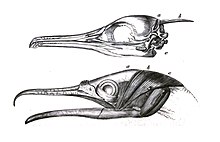
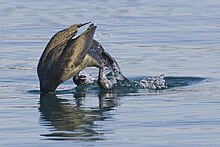



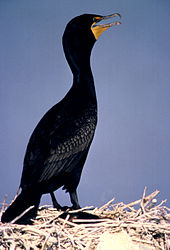

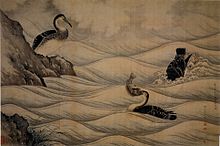
No comments:
Post a Comment
Note: Only a member of this blog may post a comment.